Brompton Electric C-Line Explore Review | Cool & Compact
This lightweight English electric city bike performs solidly while quickly folding down to an ultra-portable size.

Of course, many of these bikes feature robust motors, large batteries, and all-terrain tires to satisfy American appetites for speed and power. But what options exist for city dwellers who rely partially on public transit or those in cramped third-story apartments?
The Brompton Electric C Line Explore (the 12-Speed model) may present the ideal blend of ease, portability, functionality—and, most importantly, fun.
This e-bike, one of three electric models in the British brand’s lineup of analog and battery-powered bikes, features a proprietary folding design, making it one of the most compact models we’ve tested. Additionally, it weighs just 38 lbs, including its removable battery pack (32 lbs without), so it’s also one of the lightest.
The bike lightens its rider’s effort level with a custom 250W front-hub motor paired with a 36V, 300-Wh battery that is built into an easily removable carry bag. It feels much like a non-electric bike thanks to its responsive torque sensor, making the ride engaging, natural, and active—but not strenuous.
For those unfamiliar, Brompton is a well-established company that began making folding analog bikes in 1975 and e-bikes in 2017. With 50 years of experience under its belt, the brand has become known as the gold standard for compact cycles.
Prior to this review, we’d been itching to get our hands on a bike from Brompton! Now that we have, our goal was to discover if it was everything it was cracked up to be. Read our full review below to find out how the bike felt, folded, and performed in our series of standardized performance tests!
 Pros
Pros- It’s extremely portable—and perfect for the apartment dweller in a dense city! The Electric C Line is among the most practical folding bikes we’ve tested due to its sub-40-lb weight, small profile, and ability to roll once folded.
- The bike’s 250W front-hub motor provides a helpful amount of power for an active, fun, and responsive ride. It feels much like a regular bike, just faster and easier!
- Brompton offers an excellent warranty of 7 years for the frame and 2 years for the electrical components (this can be extended to 3). All non-wearing components have 2-year coverage as well.
- While many e-bikes are mass-produced, the Electric C Line is handmade at Brompton’s London-based factory.
- It’s compatible with a wide range of unique accessories, including a hard-shell travel case & quick-attaching luggage that incorporates the battery/control panel.
- The 36V, 300-Wh battery gives the C Line impressive range, and it recharges in just 4 hours!
- Brompton offers eight eye-catching color options, including Flame Lacquer, Matcha, and Yuzu Lime.
 Cons
Cons- The Brompton app makes changing the bike’s pedal assist level easier when riding, but we’d still prefer a handlebar-mounted button pad over the control panel on the battery.
- Proprietary components/tech and the bike’s handmade frame come at a cost; the 12-speed model starts well above $4k. The brand’s quality is noticeable, though—you get what you pay for!
- In general, we think urban/dense city riders (think New York) won’t mind the bike’s 15.5 mph pedal-assisted max speed, but some other US-based riders in more suburban environments may want full Class 2 speeds.
- Battery: 300Wh 36V with LED display
- Display: None
- Motor: 250W Brushless DC motor
- Headlight: Dynamo
- Taillights:Dynamo
- Pedal Assist: 3 Levels, up to 15.5 mph (25 kmp/h)
- Claimed Range: 20-45 miles
- Throttle:None
- App:Brompton Electric
- UL Certification:
- Claimed weight: 38.14 lbs
- Rider height range: 4’7” to 6’8”
- Total payload capacity: 242.5 lbs
- Brakes:Brompton Dual Pivot Calipers
- Fenders:Included
- Fork:Reinforced Electric specific steel brazed fork
- Frame: Precision-drawn heat-treated steel tubing with hand brazing and selected auto-brazed joints
- Drivetrain: 12-speed, 50T chainring, four inline sprockets, no hub gear, 402% range.
- Grips: Lock-on grips with soft-compound rubber adhered to an engineered core
- Saddle: Standard, 33” seatpost
- Handlebar: 515 mm
- Kickstand: None
- Pedals: Brompton Folding left-hand and non-folding right-hand pedals
- Tires: 349 x 35C Schwalbe Marathon Racer. A puncture-resistant tire with a reflective sidewall
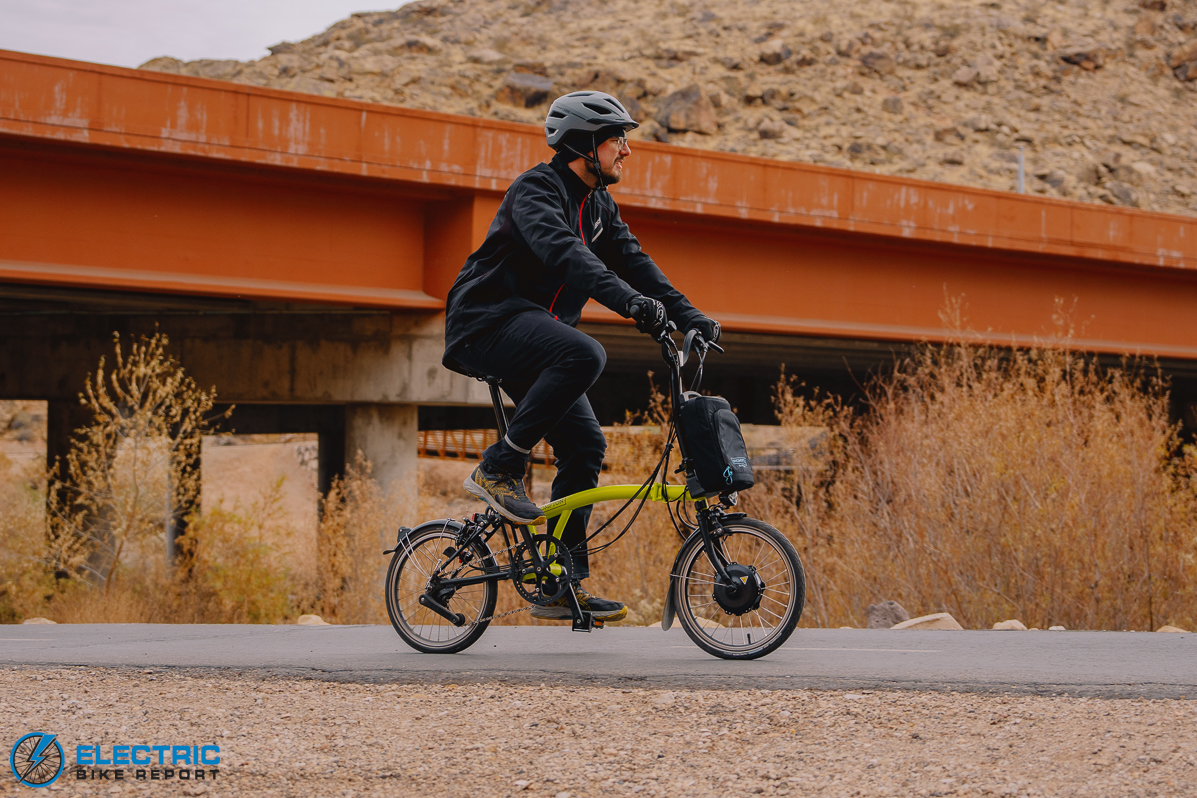
The Electric C Line is offered in a variety of 8 color options, including the head-turning “Yuzu Lime” neon yellow of our test bike.
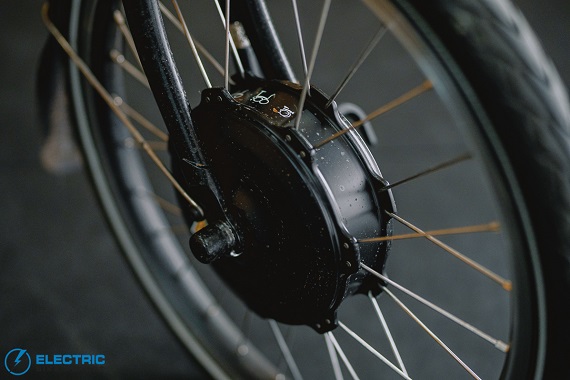
The Electric C Line is driven by a custom 250W front hub motor paired with a torque sensor.
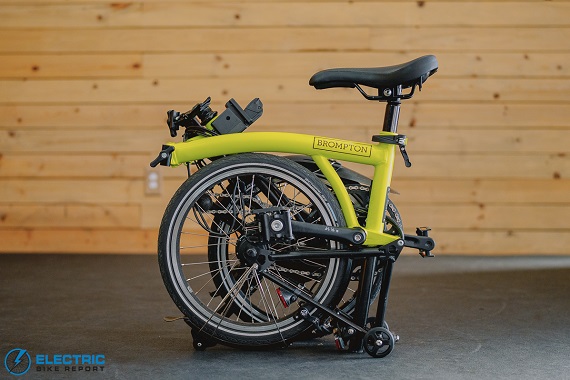
Once folded, the Electric C Line measures roughly 25” L x 11” W x 25” T and weighs 32 lbs with its battery removed.
Brompton Electric C-Line Explore Review: Speed Test
In contrast with most other folding e-bikes we’ve tested with maximum speeds of 20, 25, or 28 mph, the Brompton Electric C Line has a European-friendly motor-assisted limit of 15.5 mph (25 kmp/h). We tested the speeds of its three pedal assist system (PAS) levels by pedaling on paved multi-use paths after first establishing a baseline with no motor power.
As shown by the data in the graphic above, the bike’s first setting delivered a slight but helpful amount of power, while the second provided a more significant boost. This power level was sufficient enough when riding on flat ground to bring me to (and above, with active pedaling) the bike’s top speed, so my speed in PAS 3 did not differ significantly.
We usually prefer to see more consistent increases in speed between pedal assist levels, but Brompton seems to have taken a different approach when programming the C Line. The bike’s PAS effectively offers both a low and a mid-power setting for flat ground and then a more powerful assist mode for going over hills or enjoying the easiest possible ride.
There was a noticeable difference in PAS 2 and 3 when going by feel; PAS 3 accelerated more quickly and required little effort. Personally, I found PAS 1 and PAS 2 to be effective for general riding on flat ground and some small hills; I typically reserved the full power of PAS 3 only for steeper hills.
I appreciated the bike’s simplicity, though I also want to acknowledge that some of the aforementioned American appetites may not be satisfied by the bike’s 15.5 mph speed limit.
We expect the bike’s speed will be suitable for those in dense cities, but those in more suburban areas may prefer the ability to reach 20 mph. As such, we wouldn’t mind seeing a full Class 1 model from Brompton—or even a Class 2 bike with a throttle—but at least for now, the company’s e-bikes are somewhat more limited.
Regardless, we feel the C Line performed well in this test with responsive pedal assist and intuitive programming.

It’s hard to avoid wearing a big grin when riding this bike; its design simply makes it fun to ride!
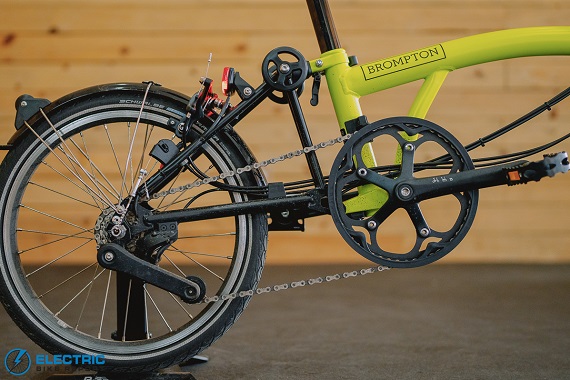
The Explore model has a 12-speed 3×4 drivetrain: a 3-speed internal gear hub combined with a 4-speed cassette/derailleur.
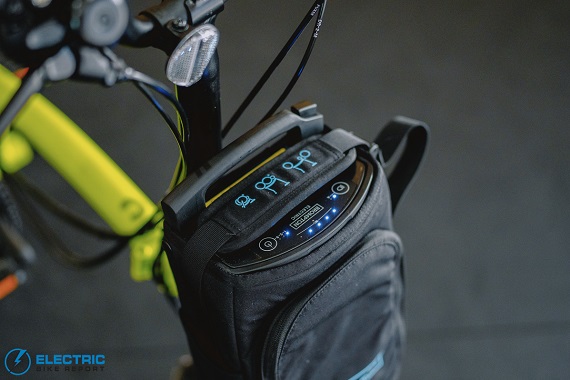
The bike’s 300Wh battery is built into a removable storage pack that also includes charge indicators and a control panel.
Brompton Electric C-Line Explore Review: Range Test

We tested the Electric C Line’s motor and battery efficiency in two separate Range Tests; see the graphic above for our results and a description of our testing methods.
As shown, we were able to meet and slightly exceed Brompton’s advertised range. The bike also performed well when compared to similar models we’ve tested: folding e-bikes with 250W and 300W hub motors averaged 23 and 36 miles in their max-assist and min-assist tests. This made the C Line roughly average in PAS 3, but it had a 16-mile lead in PAS 1.
What is the reason for this lead? The answer is likely the Brompton’s torque sensor, which allows its motor output to fluctuate depending on how much pressure the rider applies to the pedals. Most of the other bikes used for comparison had less efficient cadence sensors, so their motors were always putting out a constant flow of power and using more power.
It is worth acknowledging that the C Line’s battery capacity is somewhat on the smaller side (300-Wh versus the average of 351-Wh), so the bike had a bit less gas in the tank than many of its peers. This made its average result in PAS 3 more appreciable; it would likely have had below-average performance with a cadence sensor.
Regardless, the bike demonstrated great range for its specs in this test. We think most riders are likely to use the C Line for relatively short trips between the subway/bus station and the office, which it is extremely well-suited for. However, those looking to spend a full commute on two wheels should have enough gas in the tank for at least one round trip.
To touch back on what I said in the Speed Test section, PAS 1 or 2 seemed plenty powerful for flatter areas, so riders sticking with those low or mid-power levels should be able to stretch out their range. When it’s time to recharge, the process takes about 4 hours (and you can plug it in on or off the bike), so those with a long commute and a short shift should be covered.
Brompton Electric C-Line Explore Review: Hill Test
Compared with other e-bikes equipped with 250W hub motors, the Brompton performed well; its time of 1:52 and average speed of 9.7 mph lined up closely with the pool’s 1:55 average.
The Electric C Line’s motor is proprietary; beyond its nominal 250W output, we do not know its peak wattage or torque rating. As such, further analysis is difficult, but based on the bike’s results, its motor is performing as it should.
In the grand scheme, 250W motors are relatively subtle—but still helpful in reducing strain and extending ride times. Motors of this power level are typically reserved for bikes that prioritize a natural feel, and to be clear, riders of the Electric C Line will need to put in some legwork when traveling uphill.
From personal experience, I can attest that Hell Hole Trail is not a path that most riders would attempt to pedal up without help from a motor. The fact that our tester, Justin, was able to reach the top without feeling exhausted or completely out of breath proves that Brompton’s motor made a massive difference.
To reiterate what I mentioned in the Speed Test section above, I found PAS 2 effective for average hills, but riders needing extra power for intimidating hills can take advantage of PAS 3—just remember that using a higher level of assist will use up battery charge faster.

We thoroughly enjoyed the Electric C Line’s natural feel, responsive motor, and nimble handling.
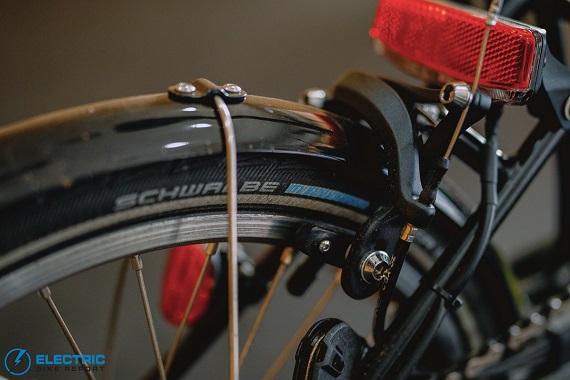
The bike has a rim brake system with dual-pivot calipers.
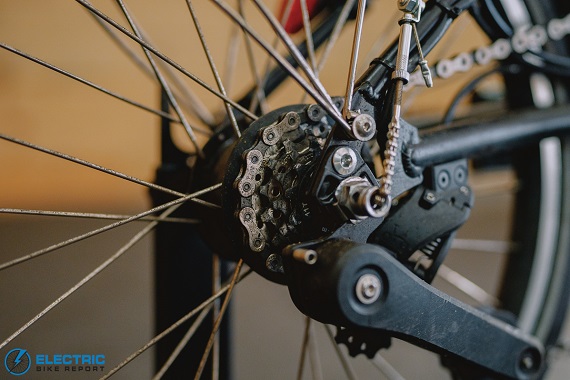
The 3-speed internal gear hub (IGH) is made by Sturmey-Archer.
Brompton Electric C-Line Explore Review: Brake Test

The Electric C Line is equipped with a rim brake system with dual-pivot calipers. We tested their performance and the bike’s stopping power in our Brake Test using the method described above. The bike’s average after three tests was 19’9”, which is well within our ideal range of results, though there are more details to explore.
The Brompton differs from most other folding e-bikes we’ve tested in two aspects that make comparison difficult: its type of brakes and its maximum speed. Most of those other bikes used either hydraulic or mechanical disc brake systems, which are generally considered to be more effective.
Additionally, while we tested most other bikes at 20 mph, the Electric C Line’s motor does not propel the bike to such a high speed. Generally speaking, the faster a bike travels, the longer it takes to stop—or the harder its brake system has to work—so theoretically, the Brompton should be easier to bring to a stop.
Did these factors balance out? It’s hard to say for sure, but let us consider the performance of similar folding e-bikes with mechanical disc brakes. Broadly speaking, these should perform somewhere between the C Line’s rim brakes and other bikes’ hydraulic systems. Those other bikes averaged 22’4’, making the Brompton 2’5” shorter/faster.
Of course, we must still consider the element of speed, but we regard any results around 20’ to be excellent, so it does seem that the C Line’s differences are balanced.
Personally, I found the bike’s rim brakes to be effective, though they were noticeably slower and required more clamping pressure than the hydraulic brakes I am more accustomed to. The bike seemed to be specced appropriately, however, especially considering its focus on portability and maintaining low weight.
One final note: we do not get much precipitation here in SW Utah, but rim brakes typically perform worse in inclement weather. If you are riding in the rain, we advise giving yourself more time and distance to slow down.
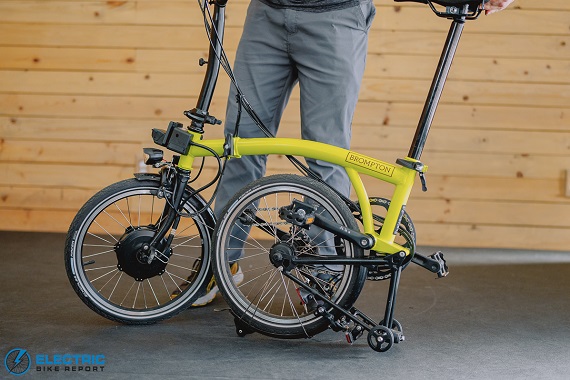
The bike does not include a kickstand, but can rest in place with the rear wheel folded under the frame.
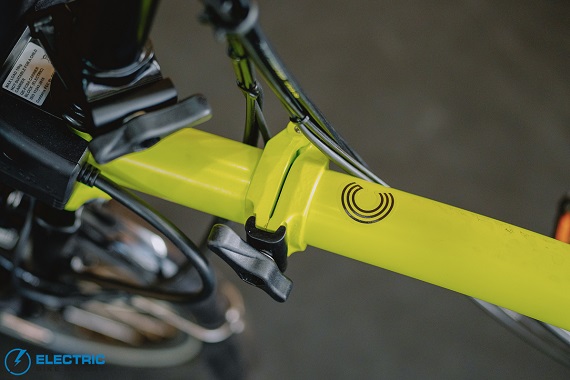
The Electric C Line’s frame has a central hinge with a twist knob/clamp keeping the joint secure.
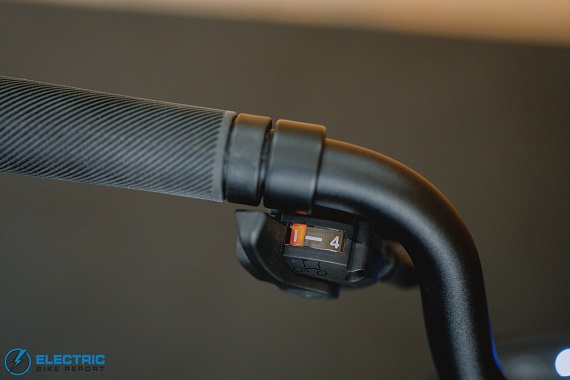
The left handlebar has a shifter for the 4-speed derailleur.
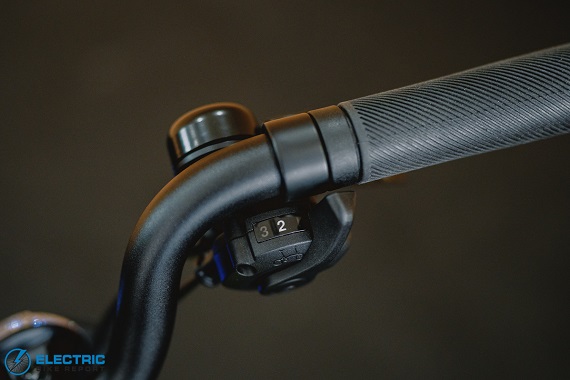
A shifter on the right handlebar operates the 3-speed IGH.
Brompton Electric C-Line Explore Review: Ride Quality
Let’s first address the elephant in the room: if you’re new to Brompton, you likely haven’t seen a bike quite like the Electric C Line before. Its geometry is certainly uncommon, with a low, stretched-out frame, an extremely tall seatpost, and tiny 16” wheels. I’ll admit that when I set eyes on it, I expected I’d feel like a circus bear riding a miniature bicycle.
To be fair, there is an inescapable element of that sensation, but it felt and functioned much more like a full-size e-bike than I expected on my first ride. The bike’s geometry felt comfortable, intentional, and dialed in, with plenty of room for adjustability. I was immediately impressed; this was clear evidence of Brompton’s 50 years of experience.
In fact, the Electric C Line is made to accommodate a gigantic range of riders from 4’7” to 6’8” with a single frame size (and a caveat).
The bike has two stem/handlebar height options at purchase and is compatible with three seatposts. The included standard seatpost is for those with a 26”-33” inside leg measurement, but there is also an extended seatpost to accommodate those with up to a 35” measurement and a telescopic seatpost that goes up to 39”.
At 5’11”, I found the standard seatpost and mid-size stem/handlebar option on our test bike to be comfortable. I was able to achieve proper leg extension and experienced a moderate forward lean to the riding position. I’d likely opt for the taller stem for a more upright position, but that’s largely up to personal preference.
In terms of handling, the Electric C Line is generally nimble, thanks to its 38-lb weight and 16” wheels. Between its battery pack and front hub motor, most of the bike’s weight is on its front end, so its steering did not feel as quick as I expected based on those other factors —or, thankfully, as twitchy as I feared based on the bike’s narrow 515-mm handlebars.
The C Line features no suspension and narrow, small-diameter tires, so bumps can be noticeable, but the bike’s steel frame does a remarkably good job of absorbing vibrations. I was surprised by the softness of the ride when traveling in areas where other bikes with rigid aluminum frames felt stiff and jarring!
I’ve discussed the responsive and natural feel of the bike’s motor, but it’s worth mentioning that engaging the motor sometimes required an initial “shove” on the pedals. This was only a slight hiccup and was something I adapted quickly to.
One area of critique that I have is with the bike’s user interface. I found it somewhat difficult to change the bike’s pedal assist setting when moving due to the placement of the control panel on the battery pack; doing so required removing a hand from the bars and reaching over or around the stem and handlebars.
The Brompton Electric app allows users to adjust the PAS level and includes a speedometer (no display exists on the bike), so I found it a welcome addition to the bike with an added phone mount. Regardless, I encourage Brompton to include a handlebar-mounted remote/button pad on the handlebars—or, at the least, offer one for purchase separately.
Additionally, while I appreciate the flexibility of the Explore 12-speed model, I found myself shifting often. On a “one-by” drivetrain (with a single chainring and a multi-speed cassette), this process is simple, but the C Line’s two shifters sometimes felt like a lot to manage, especially considering that I found myself straddling the first and second hub gears.
Still, riders dealing with hills will likely appreciate the wide range of speeds. Those in flatter areas—or those who prefer simplicity—may find the 4-speed Urban model to be enough.
But John, you might say, you haven’t yet talked about how this folding e-bike folds. Let’s remedy that, as it’s similar to but also different from most of the other folding bikes I have reviewed. The process is ingenious, but it also has a learning curve; fortunately, Brompton includes diagrams showing the steps on the battery pack and on stickers in multiple places.
First, a release lever behind the seat tube allows the rear wheel to swing under the frame. Then, once the clamp on the hinged frame is released, the front wheel can swing around to hook on the chain stay of the folded rear section.
At that point, the collapsible stem can be released, allowing the handlebars to fold flat and secure in place. Finally, the seatpost can be dropped and the left side pedal folded down. Once all is said and done, we measured the folded bike to be roughly 25” L x 11” W x 25” T.
One final thing to discuss is the range of optional accessories Brompton offers for the Electric C Line. Of particular interest are both hardshell and soft travel cases for transporting the folded bike. A larger storage bag and rack are also available for the front-mounted battery.
Hopefully, it’s clear that the Electric C Line’s ride quality is both generally great and exceptionally unique! I found the bike comfortable, easy to use, and extremely functional, so I think it’s clear why Brompton is regarded so highly in the industry.
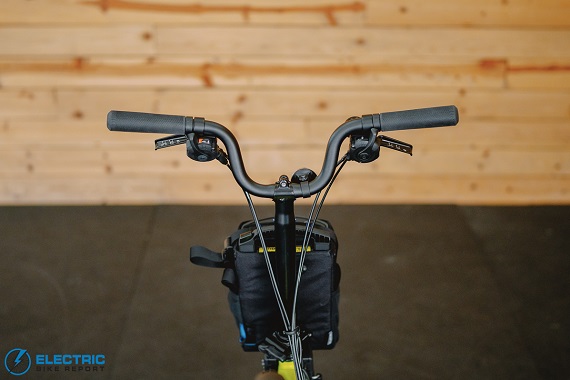
The bike features narrow 515-mm handlebars on one of two stem options.
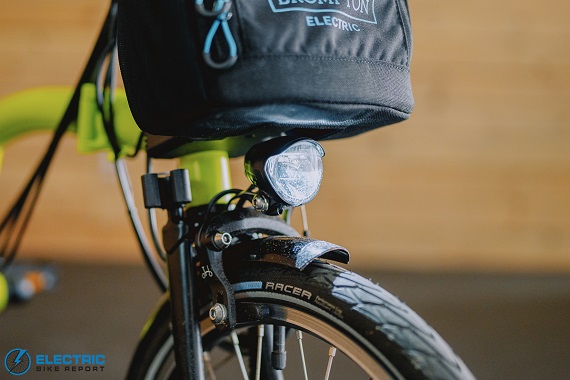
An integrated headlight and tail light provide low-light visibility.

The hinged rear triangle includes wheels that allow the bike to roll once it’s folded.
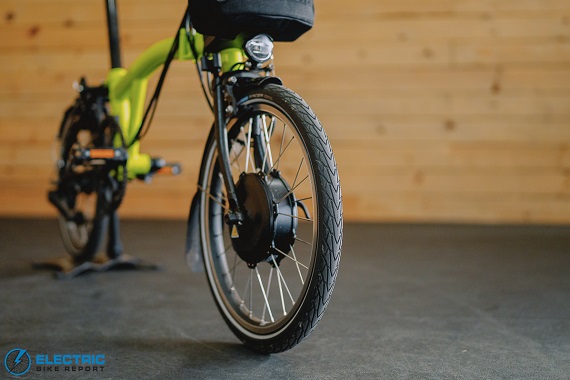
The Electric C Line rolls on custom 349x35C Schwalbe Marathon street tires.
Brompton Electric C-Line Explore Review: Summary / Where to Buy
Thanks to its compact and lightweight folding frame, the Electric C Line is extremely portable and storable, but that doesn’t mean it sacrifices performance for function. When looking back at the bike’s test results, it met or exceeded our expectations in all areas, with particularly outstanding performance in our Range Test.
Admittedly, the C Line’s European-friendly speed limit and premium price (the Explore model we tested starts between $4k and $4,500) makes it a relatively niche product, but riders seeking or accepting of these factors will not be disappointed.
The bike’s quality and functionality are worthwhile; it’s worth remembering that Bromptons are made by hand in England and are loaded with custom components and proprietary technology you won’t find elsewhere.
They also have a phenomenal warranty; once registered, the frame is covered against manufacturing/material defects for 7 years, the electrical components are covered for 3 years, and non-wearing components are covered for 2 years. You definitely get what you pay for!
We encourage the company to consider offering a full Class 1 or Class 2 model in the future, as we feel a higher 20 mph speed will be desirable to US consumers in suburban or rural areas. Additionally, we feel that handlebar-mounted controls (or the option to add them) would make the Electric C Line more user-friendly.
As it is, we highly recommend this e-bike to those seeking a lightweight and ultra-compact method of transportation. If you live in a cramped apartment or you need a bike you can easily take on public transit, the C Line Explore may just be the bike for you!
Happy Riding! Make sure to let us know if you have any questions or if you think we left anything out in this review of the Brompton Electric C-Line Explore down in our comments section.


